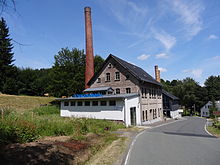Wagner & Apel porcelain
Wagner & Apel Porzellan is a porcelain manufacturer in the small town of Lippelsdorf in the Thuringian Forest . Porcelain has been manufactured there by hand since 1877 . The product range includes realistic animal and bird sculptures, children's figurines, Christmas and gift items and vessels. The family company is run by the fourth and fifth generations.
history
In 1877 a porcelain factory was founded in Lippelsdorf under the name "KUCH & Co.". The entry in the land register read "Kiln built in local corridor". Bernhard Wagner was one of the founders. From May 31, 1901, the owners Bernhard Wagner as well as Anton and Bernhard Apel operated under the name "Wagner & Apel". As such, the Lippelsdorf porcelain made a name for itself worldwide.
While at the beginning mainly the production of pipe bowls, Mugs, egg cups, bathing children and other small export goods was primarily the production from 1901 on was Nippes , animals and gift items changed. Over the years, the collection of small consumer items such as cans, ash trays, shakers, pin cushions, cruets , etc. has been expanded.
So the factory was carried on from generation to generation. Like all medium-sized companies in the socialist GDR , Wagner & Apel became a company with state participation in 1960 . In 1972 the company was completely expropriated and now traded as " VEB Porzellanfiguren Lippelsdorf". Four years later, all the porcelain factories in the area were merged to form "VEB United Zierporzellanwerke Lichte". Lippelsdorf became the manufacturing department of the Graefenthal division. With this the company lost all independence and decision-making authority. After the political change, the descendants of Bernhard Wagner, Ingeborg Seibert and Helga Koch, applied for the reprivatisation of the factory, which then went back into private ownership on July 1, 1990. Ingeborg Seibert and Helga Koch and Hans-Heinrich Seibert as managing directors are now shareholders of the GmbH .
Historical porcelain factory
With the support of the State Office for Monument Preservation, the workshops of the old Thuringian craftsmanship were restored by 2002, the 125th anniversary of the company. In the old factory there is, among other things, a multi-storey coal firing furnace, a pulp mill and a steam engine from 1937. The old porcelain factory has been named a technical exhibit . Visitors are given the opportunity to tour the traditional production facilities. In 2005 the Seibert family was awarded the Thuringian Monument Protection Prize in recognition of their achievements .
See also
literature
- Ekkehardt Kraemer (ed.): Saxon-Thuringian manufactory porcelain. Glass ceramic. Publicly owned foreign trade company of the German Democratic Republic, Berlin 1985. 3rd expanded edition 1987 pages 24–27.
